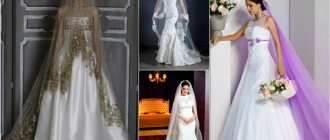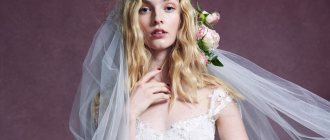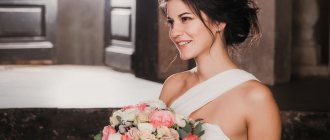Why does a bride need a veil: traditions and signs
Almost every nation has a tradition of covering the bride's head and face. In Rus', instead of the usual light veil, the bride was covered with a thick scarf, also covering her face and shoulders. This is not just a protective attribute and a symbol of innocence, but also a special sign that the bride is now considered “dead” for everyone except the groom. No one should see her beauty.
For Muslims, the woman's face was not revealed at all. Only her husband could see her after the wedding and no one else. The veil was not removed either during the festival or after it.
The veil is the most ancient wedding custom. This attribute was believed to have magical properties. The veil could not be touched by anyone except the bride and her mother. It is especially important that no one touches the veil before the wedding. It is also impossible to measure it, because by putting on a veil, a girl becomes a bride and must get married, and if this does not happen, fate may present unpleasant surprises in the future.
There are several options for who removes the bride's veil at a wedding. According to one version, only the spouse can remove the veil after the celebration. Only him and no one else. Even the bride herself should not remove her headdress. This could bring disaster to the family.
However, now the ritual of removing the veil is a separate part of the holiday. The mother-in-law can remove the veil as a sign that she is accepting a new daughter into the family, as well as the mother of the bride, then covering her head with a scarf. This means that the bride has become a wife and mistress.
It is believed that a veil will protect the family even after the wedding. It was used to cover a child's cradle to protect him from the evil eye. For this reason, you should not let your friends and even daughters try on your veil. Previously, veils were never sold or given away, but over time it became fashionable to take such things without renting them.
Why does a bride need to cover her face with a veil, what to do with the veil before the wedding and during the ceremony?
- The veil is an inviolable attribute that no one has the right to touch before the wedding celebration, except the bride herself or her mother. Or an older relative, if the girl who is about to walk down the aisle does not have a mother.
- The ancient Slavs believed that covering the bride’s face with a veil was the mother’s responsibility. They strictly followed this rule, but why did they do this? The answer to this question is lost somewhere in the depths of centuries.
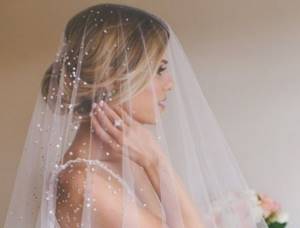
The bride's mother should cover the bride's face with a veil.
- In the old days, the bride was strictly forbidden to try on a veil along with her wedding dress before the wedding. As they believed then, this could bring shame on the family or even lead to tragic consequences. Our ancestors saw a sacred principle in this ritual. Maybe it makes sense to stick with it now?
- Not only eastern girls covered the bride’s face with a veil throughout the entire wedding ceremony; they did the same in Russia. Only the groom could open his beloved’s face for a kiss during the wedding - then he only threw back the veil. And when the wedding ended, he personally freed his now wife’s head from it. This is also a ritual - with such an action, the newly made spouse seemed to lay claim to his other half.
- Other customs have also appeared: at some weddings, the mother-in-law removes the veil from the bride and ties a scarf instead. In other cases, it is done by the bridesmaid, her mother, or herself. And this is wrong, or at least not the way our ancestors did it.
During the wedding, the bride's mother must ensure that her daughter's veil is not torn off. Whether it’s an accident or someone’s deliberate malicious intent - it doesn’t matter, it’s a bad sign.
- If during a wedding ceremony the veil suddenly gets caught on something, then only the groom has the right to correct it, no one else.
Pros and cons of veils
An attribute such as a veil has its advantages and disadvantages. The advantages include a solemn appearance. It is the veil and white dress that make a bride a bride. The veil gives the image a more romantic, fabulous, memorable look. A veil will help hide some imperfections in your dress and figure.
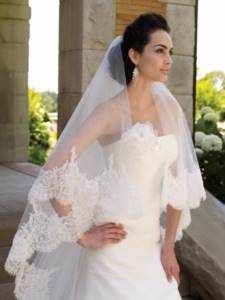
For some, an undoubted advantage is the opportunity to observe traditions. If you believe that a veil is a talisman that will protect your family, there is no reason to refuse it.
If you are planning a photo shoot, a veil will serve as an excellent assistant. You can come up with many poses for photographs.
The disadvantages include some inconvenience. If the veil is long, then the inconvenience only doubles. You can step on a veil or get caught on something. In addition, a long veil is heavy. However, many brides do not notice this during the celebration.
For a veil you need to choose a hairstyle. If the veil is heavy, you need to create a tight enough bun to hold it in place.
And perhaps the last drawback is the closed back and neck. For owners of a graceful neck, this may seem like a problem, but now you can find enough veil options that not only will not cover, but will also emphasize all the advantages of your figure.
Benefits of a wedding veil
Undoubtedly, the main advantage in favor of the veil is tradition. Ever since we were in school, we have imagined a wedding outfit consisting of a fluffy white dress and a veil. For many, this accessory seemed an integral part of a wedding outfit.
And if we turn to religion, then the bride should not approach the altar with her face open at all. But who pays attention to religious prohibitions these days? And only a few began to get married in church. Many newlyweds get married in the registry office, have a wedding, go to the sea for their honeymoon and leave it at that.
There are a lot of folk signs and beliefs associated with the veil. For example, the most famous sign: the longer the veil, the longer and happier the newlyweds’ marriage will be. Whether to believe in omens or not is everyone’s choice, however, many happy and long-lasting unions are known that were married without a veil at all.
Another advantage of the veil is the fact that it is very convenient to store. After the wedding, you really want to leave a piece of your festive outfit as a souvenir. Some people store dresses - but this option is only suitable for those families who have a large wardrobe. It is easier to store a veil, it does not take up much space, and it will bring no less impressions and memories than a wedding dress.
Let's not forget that the veil gives the bride a certain mystery and innocence. Probably, many are familiar from movies with the moment when the groom, in front of the altar, removes this aura of mystery from the face of his chosen one. What romance!
How to choose a wedding veil: length options
Usually, a girl develops an image of an ideal outfit long before a marriage proposal. She already knows what hairstyle, veil, etc. she wants. But starting to find out what options there are, the bride gets lost, she wants to try on everything. It is worth remembering that the bride’s veil should be in complete harmony with the dress. Although from the point of view of traditions it is impossible to try on a veil and a dress, fashion and style require it.
A veil can differ in many aspects. If we talk about length, the classic length is below the shoulder blades. All that is shorter is not a veil, but variants of veils.
- Shoulder length veil . Not quite a veil in the traditional sense of the word. A favorite option for practical brides who don’t want to wear a heavy head and get tangled in fabrics. It will highlight the beautiful back of the dress. This veil is not suitable for a wedding.
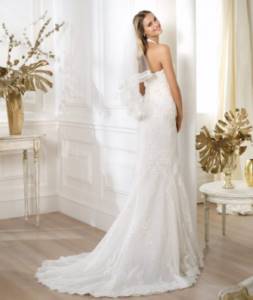
- A veil up to the middle of the arm is the most common option. Not long or short, comfortable, covers the ties or fasteners on the dress, but does not affect the hem. Pairs well with a romantic look and a ball gown.
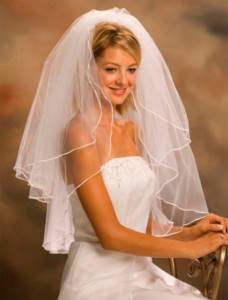
- Veil to the waistline . Slightly longer, very elegant, goes well with any dress without a train.

- Mid-thigh length veil . This veil is considered long. Favorite length of romantic natures. The veil is not so long that it interferes with walking, but it still looks very beautiful.
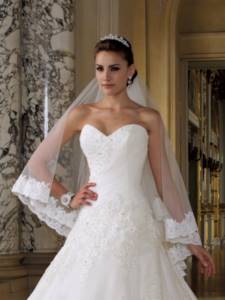
- Veil to knee level . This length of veil is often combined with midi dresses that do not completely cover the legs.
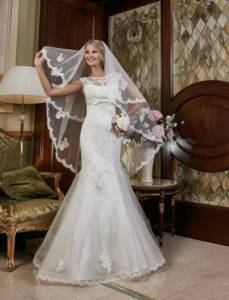
- Veil waltz . This is a toe-length veil. Quite heavy, you can get tangled in it, but it looks luxurious. The length of the veil is usually more than one and a half meters. Depending on the height of the bride, such a veil will look different. Pairs well with a dress without a train, suitable for tall and slender brides.
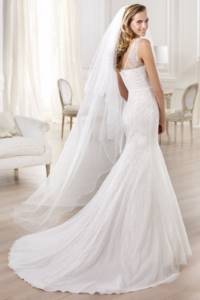
- Veil for the chapel . More than 2 m, goes well with the train of the dress, heavy but aristocratic.
- Cathedral veil . Veil of breathtaking length. Its length can reach 3 m or more. The dress does not have a train. It is better to prefer a regular long dress so that the fabrics do not get tangled. Such a veil is not suitable for wild fun and dancing; it is better to change it during the holiday.
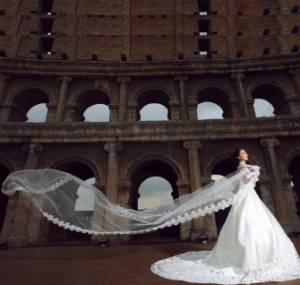
How to wear a veil for a bride at a wedding?
This question worries the bride almost more than all the others. The photos presented here will help you choose the appropriate hairstyle with a veil.
Editor's choice: Decorating the presidium for a wedding, ideas with photos and videos
In this case, it is necessary to take into account the length of the bride’s hair.
The following accessories are used as an element for fastening veils:
- headbands;
- wreaths;
- ribbons;
- hats;
- tiaras.
Loose curls go well with a veil attached with a wreath, and for high hairstyles, pins are more appropriate.
Owners of long hair often choose a bun with a veil, and it is attached in such a way that it is possible to hide the face and then throw the veil back.
Wedding veil: width and layers
The width of the veil determines its pomp. The wider the fabric, the more magnificent and dense the veil.
- 135 cm. Thick fabrics are almost never used now, so with this width the veil turns out to be a soft, light and transparent veil. She doesn't cover her shoulders. The dress will show through. This should be taken into account when trying on a dress.
- 180 cm. The most traditional option, slightly enveloping the shoulders. Looks very good in combination with dresses with straps and open tops.
- 270 cm. The widest curvy one. Looks good with an open top and a simple dress without unnecessary lace or drapery.
A veil can have a maximum of 3 layers, a minimum of 1. Do not make more than 3 layers, it will turn out to be a very heavy veil, and it will simply be uncomfortable to wear. The simpler the dress and hairstyle, the more layers the veil can have. A multi-layered veil is often chosen by brides who want to keep their face covered during the ceremony.

A three-layer veil cannot be short, because the top layer covering the face must be at least 75 cm. A single-layer veil looks good with a lace top and a complex dress. For a romantic look, a veil with 2 layers is more suitable.
What does the accessory symbolize?
It is a symbol of devotion, purity, chastity and modesty. It is not recommended, following fashion trends, to refuse to use a veil or to shorten it too much. The girl’s task is to carefully monitor the condition of the wedding attribute, because it is designed to protect the family from adversity.
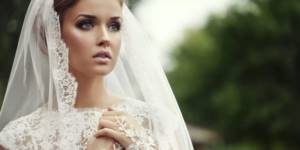
The most common signs about the bride's veil:
- the longer it is, the longer the husband and wife will live together;
- if she is engulfed in the flames of fire, a turbulent future awaits the spouses;
- if the veil falls at a wedding, then the sign warns the newlyweds about a future divorce;
- a hole is discovered in the fabric - other people will interfere with the spouses’ relationship;
- getting married without covering your head means lies, mistrust, disappointment;
- replacing a veil with a hat means that you will be unprotected from the bad thoughts of others, which can affect the fate of the newlyweds;
- It’s a bad omen to get married in someone else’s veil;
- Only the girl’s mother can wear a veil, and in her absence, an older sister or other close relative.
If the celebration did not take place for some reason, you need to ask the young man who is not a close relative to remove the veil. This should not be done by a father, brother or son, otherwise the woman risks remaining lonely in the future.
Is this attribute required?
The accessory signifies virginal purity and is designed to hide the beauty of a girl getting married from other men who might love her. From now on, she belongs only to her husband. When the newlywed reveals his beloved's face before the altar, he declares his rights to her and takes responsibility for his wife. In addition, the veil protects against the evil eye and envy of others.

Each representative of the fairer sex independently decides whether to wear a veil or not. Some brides do not want to use this attribute for a number of reasons:
- if they are not getting married for the first time;
- due to age - after 40 years, a veil is not entirely appropriate;
- do not want to hide a beautiful hairstyle under a cloth;
- for the sake of saving money;
- there is no time to select an accessory to match the dress;
- some girls think that the train will become a hindrance during the holiday.
Advantages
As a child, every girl imagined herself in a white dress with a veil. The beginning of a happy family life is associated with it. Many are sure that the attribute is necessary at a wedding. Reasons for such judgments:
- At weddings, women always cover their heads, showing humility and submission;
- a thin train helps to hide figure flaws, skin defects on the shoulders and back;
- photos of the bride with a veil are magical and mysterious;
- girls respect ancient traditions and they want to follow them.
Read also What causes stye on the eye according to signs
Flaws

Some women still refuse to wear a veil, not paying attention to the signs. For some, the accessory does not suit the style, others do not want to experience inconvenience during the holiday - guests can step on the fabric, get caught and even accidentally tear it off their heads, thereby bringing trouble to the young family. Some people decide to do without a veil because they cannot afford expensive jewelry.
Veil requirements
This accessory is not only an adornment for a young woman, but a symbol of chastity, the bride’s willingness to completely trust her chosen one, become part of his family, clan, and say goodbye to her old life. One of the main requirements for an attribute is that it must be new. You cannot ask a friend or sister for a wedding veil, or rent one from a salon. Accepting something as a gift is dangerous - you will live someone else's life, repeat the mistakes of another family. It is permissible to purchase a used product from a stranger.
The second requirement is that the veil must be long. Ideally, it falls almost to the floor. This portends a long life together, full of love, joy and wealth. According to a sign, a bride who prefers a short veil may give birth to a sick or weak child.
Tips for choosing a veil
The accessory must match the dress, so the entire outfit must be purchased at the same time. It is not necessary to choose only a snow-white headdress; any light shade will do. The main thing is that the ensemble as a whole looks harmonious both live and in the photo.
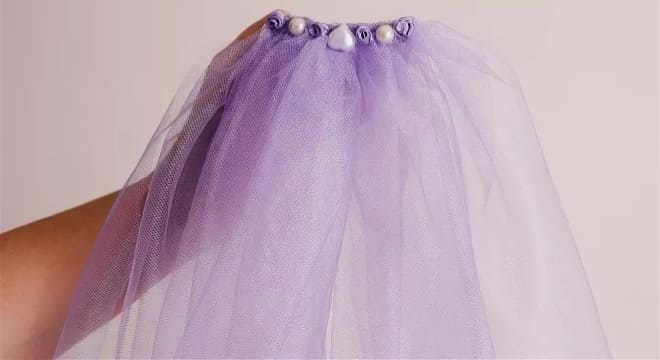
When choosing an outfit, you cannot try on all its parts at once - this is a bad omen. You are only allowed to wear full wedding clothes and look in the mirror on the day of the ceremony. Those who rush things will attract trouble. If you follow the superstition, you only need to wear a dress, gloves and shoes at the fitting, and a headdress later.
Married without a veil
Some modern girls view the veil as a boring and old-fashioned decoration. For some, a delicate accessory resembles a curtain, while others simply do not want extra expenses and inconvenience. The newlywed can do without this attribute if the meanings of the signs are not important to her:
- getting married with your head uncovered means bringing failure and suffering to your family;
- Decorating your hair with flowers for a wedding without wearing a veil will, according to the sign, lead to weakness, material difficulties, discord, and misunderstanding;
- Replacing an accessory with a hat will lead to damaged relationships and destruction of marriage bonds.
Is it possible to wear someone else's veil?
The sign about someone else's veil says that troubles await both the bride who put it on and the woman who borrowed her thing. However, the superstition does not apply to the newlywed’s mother - in the old days it was customary to donate jewelry to the daughter if the father and mother lived happily for many years.
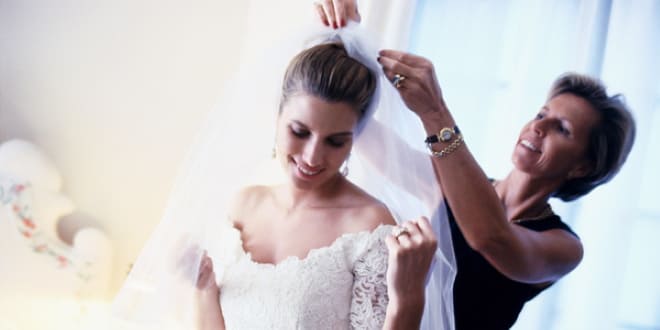
After the wedding ceremony, you should not give your item to a friend to try on or take it with you - in the future she may steal your happiness and take your husband away. According to the sign, the loss of this attribute promises separation from your spouse.
How to choose a wedding veil according to the style of the dress
Girls rarely think about what the bride's veil should be. They simply come to the salon, and the consultant selects a dress and a suitable veil. But if you decide to sew everything to order, you need to think through your image to the smallest detail in advance. Everything should be harmonious: dress, hairstyle, veil, accessories.
When choosing a veil, many aspects are taken into account:
- Dress style . The simpler the style, the more complex the veil. However, you should not buy the richest veil in the salon with a scattering of rhinestones and lace. It will be too distracting. The bride herself, her beauty and smile should always be in the foreground, then the dress and then the veil. For ball gowns, a short or single-layer veil with a small amount of lace is suitable, and for fitted dresses in the Fish style or straight cut, you can choose a fuller and richer veil.
- Dress decoration . The decor should match at least in general terms. If the dress is lace, the veil may have lace elements. If there are beads on the belt or hem, the same should be on the veil. But this does not mean that you should buy an equally lavish veil for a lavishly decorated dress. A few common elements are enough to make everything look like a single whole. Please note that the lace is similar in weave and color.
- Dress color . Usually everything is strictly white or light (ivory, cream, beige). But recently it has become fashionable to make the veil brighter, pink or turquoise, although the dress can remain white. Such a bright veil needs to be complemented with accessories, choose shoes, a handbag or a belt to match.
- Dress cut . Pay attention to your back. When trying on a dress, place a mirror so that your back is visible. If the dress is tailored in such a way that the back is no worse than the neckline, you can safely choose a short or transparent veil. But it is advisable to hide the various lacings.
- Dress fabric . Of course, it is not always possible to choose a veil from the same fabric, but in appearance they should have something in common. For example, shine, shade, texture.
You should not always believe consultants who assure you that this is exactly the type of veil that should go with this dress. And even more so, you don’t need to change your favorite dress if a veil of a similar cut doesn’t suit you. There are always options.
Why does a bride need a veil?
A wedding veil for a bride can be of different lengths, colors, made of different fabrics, and decorated. It is important that the newlywed has one. Traditionally, the veil was snow-white. Today, the veil is matched to the wedding lace dress, the color of which can be very diverse. The most common colors for veils are: white, milky, pearl, golden, pink, beige and even black.
KNOWLEDGE BASE: Wedding in green - beautiful, bright, fresh
The bride's black veil is an unusual, original headdress that will give the girl sophistication, elegance, femininity, and piquancy.
The hero of the occasion will be able to outshine anyone with her beauty, as she will look simply chic in a black veil, attracting attention.
A black veil made of openwork lace will suit a dress of any color, but is especially combined with a white dress that has inserts of black material.
A black veil is combined with accessories of the same color: gloves, bag, bouquet, earrings.
A version of the classic fluffy dress in different shades: red, white, pink goes well with a black veil, which can be decorated with rhinestones, stones, and beads.
Veil as a symbol of a newlywed girl’s transition from one family to another
Bridal veil according to face type
Before heading to the salon, you can narrow down your search by understanding what type of veil you should try on. The veil is located in close proximity to the face, frames it, and therefore can emphasize or hide flaws and features of the face.
- Oval face . This face shape is considered ideal. You can wear any veil, except one that is too short and wide, such a veil suits few people, it will make the face smaller.
- Long face . A medium-length fluffy veil will suit a long face. It will not visually narrow the face even more, but on the contrary, it will emphasize all the advantages.
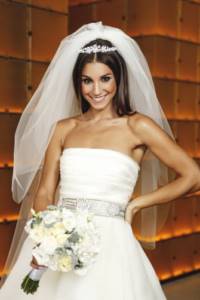
- Round face . Chubby brides are recommended to wear a high hairstyle and a thin, light veil. These tricks will help you visually elongate your face. The veil should slightly touch the sides of the face.
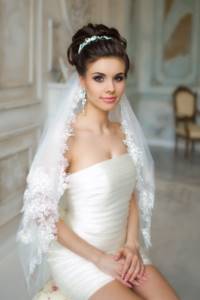
- Triangular face shape . A fluffy shoulder-length veil will help hide the narrow, elongated lower part of the face. It will add a little volume at the bottom.
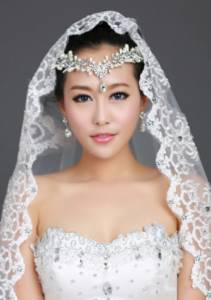
- Square face , massive lower jaw. To smooth out the face, you can buy a two-layer veil with a rounded edge; a weightless and long veil that slightly frames the face is also suitable.

- Rectangular face . For a rectangular face, a voluminous wide veil is suitable.
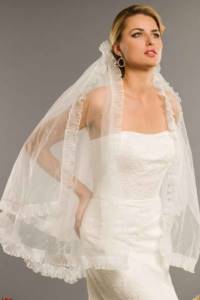
Folk signs associated with veils
It is believed that the veil should not be touched by strangers before the wedding. Only the bride and her mother can touch it. During the wedding, only the groom should reveal the bride's face, hidden under the veil.
After the wedding, the veil is used as a talisman. It is placed above the bed of young spouses so that the conceived child is healthy. To protect the baby from the evil eye, a veil is used to cover a crib or stroller.
A wedding veil cannot be sold or lent to anyone. In the same way, you cannot rent it in a salon; this wedding dress accessory must be purely individual.
Editor's choice: The best wedding gift for a friend
An alternative to the traditional veil
A veil is an undoubted decoration of a girl, but it is impossible to give a definite answer to the question of whether a veil is obligatory for a bride. Each bride has the right to decide for herself whether she wants a veil or can do without it.
There are plenty of options for replacing a veil. This is where various articles in magazines about what a bride’s veil should be and photos on the Internet come to the rescue.
- Headband . A good choice for a refined look with long hair and updos. Modest and tasteful.
- Ribbon . Wide ribbons are in fashion now. This decoration is especially suitable with a retro style dress.
- Hat . For bright and fashionable brides. The hat can be with or without a veil. The result will be a flirty and original image.
- Wreath . It will look good on young girls whose choice fell on a dress in a boho or rustic style. In addition to the flowers themselves, the wreath can contain beads, rhinestones, leaves, and twigs.
- Diadem . The choice of brides who dream of being a princess. You can attach cotton wool to it or wear it separately.
- Natural flowers . Fresh flowers in hairstyles have recently become very popular. They are chosen by both young and mature brides, since flowers refresh the look at any age. A sophisticated, collected hairstyle or loose curls will become even more beautiful with a fresh flower.
Wedding hairstyles without a veil
Many people have formed a stereotype that a wedding look must include a veil, which is why hairstyles are often adapted to this accessory. What should those brides who decide to give up this attribute do with their hair? There are a couple of stylish options that will fit perfectly into the image of a bride without a veil.
Options for wedding hairstyles without a veil:
- Loose or slightly curled hair. This is a great option for both classic and themed weddings. If the wedding will be held in the style of rustic, Provence, shabby chic or boho, then this version of the bride’s hairstyle is ideal for medium or long hair without a veil. After all, now everyone strives for simplicity. Too complex hairstyles fade into the background.
- Collected hair. An airy bun or messy braids are hairstyles that can be adjusted to any wedding style. They will look great without a veil, both in life and in photos, especially if the bride decorates her wedding hairstyle with some kind of accessory.



